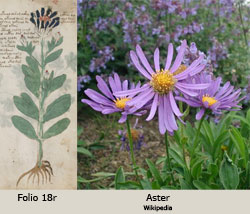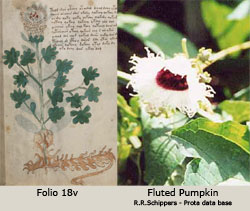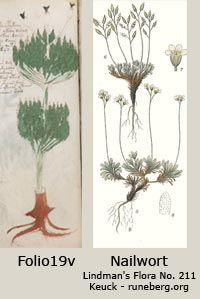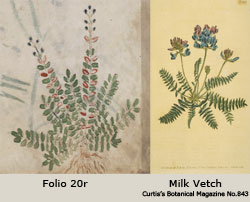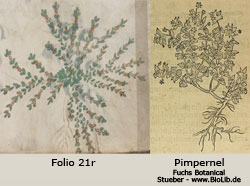The Voynich Botanical Plants
Folio 17v, Yams (Dioscorea), are tubers from a perennial, herbaceous vine, first cultivated in Africa and Asia, and are a staple part of the diet of the people of West Africa. The name yam comes from the Portuguese “inhame” which was derived from the Wolof word “nyam.” During the 14th century, the Portuguese, under the direction of Henry the Navigator, began exploring the African coastline, and it may have been at this time that yams were introduced into the Mediterranean region, along with African slaves. The W.P. Armstrong Web site shows a photograph of a yam leaf with “wings” similar to those on the leaves of the vine in folio 17v.
Folio 18r, Aster (Aster alpinus), is native to both Eurasia and North America. The name is derived from the Greek word meaning star. This perennial plant is 1 to 3 feet tall, branching occasionally. The alternate leaves are lanceolate and become smaller as they ascend up the stem. The flower has numerous small disk florets that are surrounded by about 8 to 12 ray florets. The base of mature plants can develop short rhizomes that facilitate the formation of colonies.
Folio 18v, Fluted pumpkin (Telfairia), is a large, perennial vine found in the forest zones of West Africa. It has compound leaves of 3 to 5 leaflets. The root first develops as a taproot that spreads into numerous fleshy auxiliary roots. The fruit is a large poisonous gourd, but the leaves and immature seeds from the gourd are cooked and eaten as a vegetable. (Prota Database)
Folio 19r, Greek Valerian (Polemonium coeruleum), is native to damp, temperate areas of Europe. It is not a Valerian, but a member of the phlox family. Its slender roots support numerous stems from 18 inches to 3 feet high with clusters of deep blue flowers at the end of the stalk. The pinnate leaves have individual leaflets 1/2 to 1 inch in length. An infusion of the root was used to treat coughs, colds, and all lung complaints.
Folio 19v, Nailwort (Draba nivalis), is a tiny European plant that grows in early Spring. The leaves are clustered in whorls around the plant base and the 1-2 inch long stem ends in white flowers with deeply notched petals. The plant may have been used medically for inflammations of the fingernails.
Folio 20r, Milk vetch (Astragalus hypoglottis), is a large species of herbs belonging to the Legume family, and native to temperate regions of the Northern Hemisphere. It has pinnately-compound leaves with 19 to 20 leaflets and a number of closely-packed, purple, pea-shaped flowers on stalks growing out of leaf axils. Note, in Folio 20r, the flowers appear to be at the end of the compound leaf. This plant has been used for 2,000 years in China as a kidney and liver tonic.
Folio 20v, Cardoon (Cynara cardunculus), is an artichoke thistle and a native of the Mediterranean where it was domesticated in ancient times. The blue flowers can be eaten like a cultivated artichoke and were popular as a vegetable in medieval times. The thin, spear-shaped leaves are in pairs along the stems of the plant and are covered with nearly invisible spines like those shown in Folio 20v.
Folio 21r, Pimpernel (Anagallis arvensis), is found in temperate regions throughout the world. This creeper has either blue or red flowers and the sessile or stem-less leaves are arranged in pairs along a 12 inch stem. The Greeks used this herb for diseases of the eye. The flowers are useful for treating epilepsy.
Folio 21v, Burning bush, False Dittany, White Dittany or Gas-plant (Dictamnus albus), is a native of Southern Europe. This perennial has a fibrous root system and smooth, oval, opposite pinnately-compound leaves. White or pale-red stalked flowers grow off the end of the main stem. During the summer, the whole plant is covered with a gluey, volatile substance, which may cause the plant, in very hot weather, to ignite spontaneously—hense the name burning bush. In Exodus, “Burning Bush” is the location of the place where God instructed Moses to lead the Jews out of Egypt into Palestine. The root of this plant was once used as a remedy for epilepsies and other diseases of the head, opening obstructions of the womb, and procuring the discharges of the uterus.
Folio 22r, Common Vervain or Holy Herb (Verbena officinalis), unlike most verbenas, is a perennial herb, native to Europe. Its leaves are opposite, lobed, and toothed; its small mauve flowers are arranged in delicate spikes. The name Verbena was the classical Roman name for “altar-plants.” The holy attributes of this herb may be due to the legend that it was found on the Mount of Calvary, where it was used to staunch the wounds of the crucified Saviour.

